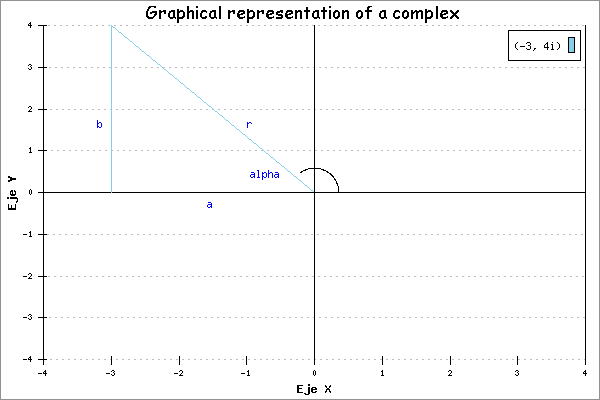Operations of complex numbers
The operations of the complex z_1, z_2, z_3 \in \mathbb{C}
\begin{cases}z_1=a+b\cdot{i} \\ z_2=c+d\cdot{i} \\ z_3=e+f\cdot{i} \end{cases}
Operation sum
To define the sum you have to comply with the following properties
Properties of the sum
- z_1+z_2 \in{\mathbb{C}}
- z_1+(z_2+z_3)=(z_1+z_2)+z_3
- \exists\text{ }0 \in \mathbb{C} | z_1+0=0+z_1=z_1
- \exists\text{ }(-z_1) \in \mathbb{C} | z_1+(-z_1)=(-z_1)+z_1=0
- z_1+z_2=z_2+z_1
As meets the above properties, the pair (C, +) has structure of grupo abeliano
Example of sum
\begin{cases}z_1=(-3)+4\cdot{i} \\ z_2=5-2\cdot{i} \\ z=z_1+z_2 \end{cases}
z=((-3)+4\cdot{i})+(5-2\cdot{i})=((-3)+5)+(4-2)\cdot{i}=2+2\cdot{i}
So we have to:
z=z_1+z_2=2+2\cdot{i}
Operation subtraction
Subtraction is a special case of the sum, to realize it you only have to use the sum of the opposite of its real parts and the sum of the opposites of the imaginary parts
Example of subtraction
\begin{cases}z_1=(-3)+4\cdot{i} \\ z_2=5-2\cdot{i} \\ z=z_1-z_2 \end{cases}
z=((-3)+4\cdot{i})-(5-2\cdot{i})=((-3)-5)+(4+2)\cdot{i}=(-8)+6\cdot{i}
So we have to:
z=z_1-z_2=(-8)+6\cdot{i}
Operation multiplication
To define multiplication we have to comply with the following properties
Properties of multiplication
- z_1\cdot{z_2} \in{\mathbb{C}}
- z_1\cdot(z_2\cdot{z_3})=(z_1\cdot{z_2})\cdot{z_3}
- \exists\text{ }1 \in \mathbb{C} | z_1\cdot{1}=1\cdot{z_1}=z_1
- \forall\text{ }(z_1) \in \mathbb{C} (z_1\ne{0}), \exists\text{ }{z_1}^-1 \in \mathbb{C} | z_1\cdot{z_1}^-1={z_1}^-1\cdot{z_1}=1
- z_1\cdot{z_2}=z_2\cdot{z_1}
As meets the above properties, the pair (\mathbb{C}-\{0\}, \cdot) has structure of grupo abeliano
Example of multiplication
\begin{cases}z_1=(-3)+4\cdot{i} \\ z_2=5-2\cdot{i} \\ z=z_1\cdot z_2 \end{cases}
z=((-3)+4\cdot{i})\cdot(5-2\cdot{i})=((-3)\cdot{5})+((-3)\cdot(-2)\cdot{i}))+(4\cdot{i}\cdot{5})+(4\cdot{i}+(-2)\cdot{i})=(-15)+6\cdot{i}+20\cdot{i}-8\cdot{i^2}=(-15)+26\cdot{i}-8\cdot{i^2}=(-15)+8+26\cdot{i}=(-7)+26\cdot{i}
In the case of obtaining a value of an imaginary square (i^2), we will take that value as your real opposite. In the example we appeared (-8)\cdot{i}, we'll take 8 as the actual number that will add to your real part
So we have to:
z=z_1\cdot{z_2}=(-7)+26\cdot{i}
Operation division
Division is a special case of multiplication, to make it only multiply the numerator and denominator by the conjugate of the denominator
The conjugated is obtained by changing the sign of the imaginary part of the denominator
Example of division
\begin{cases}z_1=(-3)+4\cdot{i} \\ z_2=5-2\cdot{i} \\ z={z_1 \over z_2} \end{cases}
z={((-3)+4\cdot{i})\over(5-2\cdot{i})}={((-3)+4\cdot{i})\over(5-2\cdot{i})}\cdot{(5+2\cdot{i})\over(5+2\cdot{i})}=
{(((-3)\cdot{5})+((-3)\cdot{2}\cdot{i})+(4\cdot{i}\cdot{5})+(4\cdot{i}\cdot{2}\cdot{i}))\over((5\cdot{5})+(5\cdot{2}\cdot{i})+((-2)\cdot{i}\cdot{5})+((-2)\cdot{i}\cdot{2}\cdot{i}))}=
{(-15)+(-6)\cdot{i}+20\cdot{i}+(8\cdot{i^2})\over{25}+10\cdot{i}+(-10)\cdot{i}+(-4)\cdot{i^2}}={(-15)+14\cdot{i}+(8\cdot{i^2})\over{25}+(-4)\cdot{i^2}}=
{(-15)-8+14\cdot{i}\over{25}+4}={(-23)+14\cdot{i}\over{29}}={(-23)\over{29}}+{14\cdot{i}\over{29}}
So we have to:
z={z_1 \over z_2}={(-23)\over{29}}+{14\cdot{i}\over{29}}
Operation sum and product
In addition to sum and product share the following property
Property of the sum and the product
- z_1\cdot(z_2+z_3)=z_1\cdot{z_2}+z_1\cdot{z_3}
As the previous property complies with, the terna (\mathbb{C}, +, \cdot) has structure of body-commutative
Example of sum and multiplication
\begin{cases}z_1=(-3)+4\cdot{i} \\ z_2=5-2\cdot{i} \\ z=z_1\cdot(z_2+z_3) \end{cases}
z=((-3)+4\cdot{i})\cdot((5-2\cdot{i})+(8+3\cdot{i}))=((-3)+4\cdot{i})\cdot(5-2\cdot{i}))+((-3)+4\cdot{i})\cdot(8+3\cdot{i}))=((-3)\cdot{5})+((-3)\cdot(-2)\cdot{i})+(4\cdot{i}\cdot{5})+(4\cdot{i}+(-2)\cdot{i})+((-3)\cdot{8})+((-3)\cdot{3}\cdot{i})+(4\cdot{i}\cdot{8})+(4\cdot{i}\cdot{3}\cdot{i})=((-15)+6\cdot{i}+20\cdot{i}-8\cdot{i^2})+((-24)-9\cdot{i}+32\cdot{i}+12\cdot{i^2})=(-15)-24+6\cdot{i}+20\cdot{i}-9\cdot{i}+32\cdot{i}-8\cdot{i^2}+12\cdot{i^2}=(-39)+49\cdot{i}+4\cdot{i^2}=(-39)-4+49\cdot{i}=(-43)+49\cdot{i}
So we have to:
z=z_1\cdot(z_2+z_3)=(-43)+49\cdot{i}

